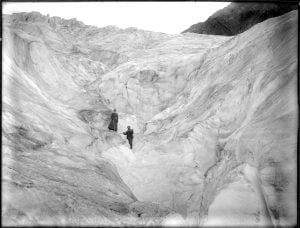
History
Frozen in time: The remarkable legacy of Mary Vaux, amateur glaciologist
Mary Vaux’s groundbreaking 19th-century study of B.C.’s Illecillewaet Glacier created an invaluable record of the glacier’s recession
- 4293 words
- 18 minutes
This article is over 5 years old and may contain outdated information.
Science & Tech

Each spring for the last six years, Wesley Van Wychen has foregone the comfort of his Ottawa home to spend weeks living in one of the planet’s most remote, inhospitable and unusual environments: Nunavut’s Devon Ice Cap in the Canadian High Arctic.
Van Wychen, a 29-year-old PhD candidate and a member of the University of Ottawa’s cryospheric research team, is one of the world’s leading experts on Arctic glaciers — how they move, and whether their rates of movement are changing with the climate. The answers to these questions are more than academic. Scientists have long predicted that melting Arctic ice will result in rising sea levels — with potentially devastating consequences for coastal communities — and glaciers are a big part of the equation.
“We know the Canadian Arctic is losing a lot of ice through surface melt and runoff, but we don’t quite know how much is lost due to the mechanical break-off of icebergs from glaciers,” says Van Wychen. By measuring the speed and thickness of some 40 glaciers that flow into the Arctic ocean, he and his team will be able to estimate how much ice is actually breaking off into icebergs, which will aid in making sea level projections.
Van Wychen is particularly interested in so-called surge glaciers, which basically lose traction and slip down the sides of mountains. One such glacier has been measured to increase its rate of flow from 10 to 15 metres per year to more than a kilometre per year. If the number and frequency of surge glaciers increases, so too would the amount of ice entering the ocean.
“We’re generating baseline data we can use for future predictions,” says Van Wychen, “but we don’t have enough data going back in time to be able to say for certain that glacial flow rates have increased due to global warming.”
In the meantime, it’s reassuring to know that researchers such as Van Wychen are venturing to the farthest reaches of our poles to gain a better understanding of the potential impacts of climate change.


Are you passionate about Canadian geography?
You can support Canadian Geographic in 3 ways:

History
Mary Vaux’s groundbreaking 19th-century study of B.C.’s Illecillewaet Glacier created an invaluable record of the glacier’s recession

Environment
The uncertainty and change that's currently disrupting the region dominated the annual meeting's agenda

Environment
As the impacts of global warming become increasingly evident, the connections to biodiversity loss are hard to ignore. Can this fall’s two key international climate conferences point us to a nature-positive future?

People & Culture
As the climate heats up, so do talks over land ownership in the Arctic. What does Canadian Arctic Sovereignty look like as the ice melts?